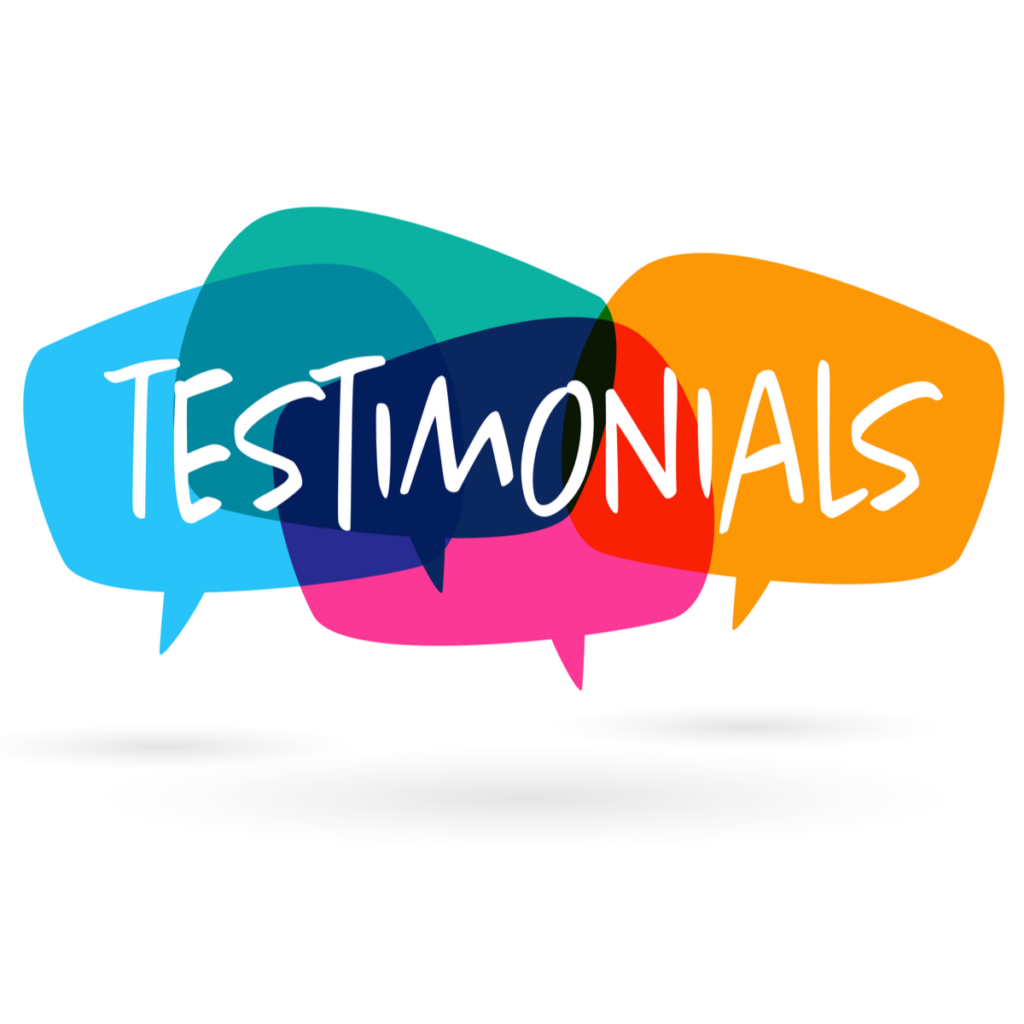Podcast: Play in new window | Download
We are continuing our series on social proof, and today we’re discussing testimonials. How you can set them up and what you can do with them, which I’ll lead onto in a second.
Excuse any weird typos, as this is a direct transcription we have had created for you.
But first, if you haven’t downloaded our marketing checklist then, you’ll find it here. There are 30 questions, and they will help you identify exactly where you are on your journey.
Let’s talk about testimonials – getting them and using them as part of your marketing plan.
Ask for a testimonial in The First Place
The first top tip is to ask for testimonials in the first place! #notetoself. Quite often, we get emails from people sharing that, by listening to this podcast, reading our content and downloading our reports, they’ve been able to implement things, move forward in their marketing and make placements, which is great. I often think, “I should email that person back and say, ‘Can I just use that as a snippet in some of our testimonials?” And I forget to do it. Slap hands to Denise. However, you don’t need to be like me.
If you dial in a system, it can make all the difference. You’ll have heard me talk about Mr Michael Gerber before – the great guy that wrote The E-Myth Seminar – if you’ve not got his book, well worth downloading. There are some real juicy nuggets in there. One of the things he always talks about is that successful businesses are built on systems. If you don’t have a system for getting reviews, I strongly suggest you work on that almost immediately.
When people join our Superfast Circle, we ask them, “What have you got in place? What systems have you got?” That way, it can help us accelerate their progress. Think about systems. The second thing is also to remember reciprocity. We’ve talked about this before – Cialdini’s principles of influence. The great influencing strategy is I do you a good turn; you do me a good turn.
For the majority of the population, if you’re in a local pub and Paul buys you a drink, likely, you will then return the favour and buy him a glass of wine or a pint or whatever he’s drinking because that’s how we are wired as human beings. This is the case when it comes to delivering a great service for candidates and clients. If you say, “You’ve had really good service from us. Would you be willing to record or write a testimonial for us?” Often, they will say yes.
Using a Testimonial
Think about how you can use this. Some people say, “Oh, I don’t want to ask for a testimonial.” Ask away because, 99% of the time, they are more than willing to shout about it and share it with other people whenever they have had good service. Thinking about all these things in context, let’s look at how you can get started. We recommend using a five-step process that will cover all the bases for you and avoid dropping balls during the process.
Ask Permission to Use a Testimonial
When you start working with someone, a great way to convince them and show them that they’re going to get fabulous service from you, whether it be a client or candidate, is to say, “Look, as we go through this process, as we find you this really good role, we always ask people for a testimonial.” You can then use this testimonial in different ways.
Describe what’s going to happen. If you would like a video, an audio or a Word document that will cover some questions, you will ask around what they think about your service and how it worked with you. Different companies have different processes. I remember doing some testimonials and case studies for a client of ours who worked with Harley-Davidson.
Unfortunately, the client didn’t check with Harley that they were happy to have a case study used in marketing for this particular recruitment company; what a huge time drain for the client.
This is something I would strongly suggest you do. Before you start using testimonials and case studies, check with the company concerned whether it’s okay that you create a testimonial and that you can use it for marketing purposes. It will save you so much time.
It can be a challenge for those of you who work with bigger corporate organizations because you often send off that case study or testimonial, and it will disappear into the ether, never to arrive back or arrive, maybe six months later when it’s lost its impact. Think through this. Like, “Who would I like to get a testimonial or case study from? Are they likely to say yes?”
Clarify the Details
Remember, clarify the process, ask if you can use their Name.
If you can use a picture or an image of them, all the better, but, again, this is something that you need to check because, remember, it makes a huge impact if you’ve got a picture of somebody. That is an even greater convincer. Think about, “Can I use all of this?”.
Video testimonials are great because people like to work with people they think will do a good job and work with people like them.
We’ve talked many times about avatars and how important it is to know who you’re working with. Imagine that you were trying to convince your avatar (that may be a 35-year-old person), and they’ve got certain things going on in their life. If they happen to see a video testimonial of someone similar to them, it is much more convincing than seeing somebody completely different.
Where to Use a Testimonial
The great way to use videos as well, of course, is to have them transcribed. If you don’t use transcription services in your business, it’s a great tool in your marketing, and it helps you leverage so many things. I’m recording this podcast, and the minute I finish it, it will be whizzed off to a transcription service. It will be back within 24 hours. We’ll do some very basic editing. Of course, the written word and the spoken word are quite different, but we put it there for those who like to read.
Imagine, if you’ve got a video testimonial, how impactful that can be because you can use it in multiple ways. We’ve looked at framing the fact that it’s going to happen; that’s number one. Number two is to let the company know that you will use it in your marketing process. We’ll come on to that in a second and give you some ideas around that.
Diarise the Process
The third thing is to set a time frame related to your delivery and diarise the process. Let’s say that you delivered a candidate. The candidate is really happy that one month after they’re in their new role, you will diarize that you’ll get in contact with them because, remember, people will be working on their time frames. Getting a testimonial from someone might fall down their area of priority. You could have it back within a week or a month; it could be two months. Make sure you diarise that process so you’ve got testimonials constantly dropping that you can use.
Make it Easy
When it comes to a testimonial, often people will say, “Well, I don’t know what to say.” Again, as that great guru, Seth Godin, told us, “People love to be led.” Here’s a bit of secret sauce that we always recommend to our clients in Superfast Circle – use questions. Give people a set of questions to answer.
So much easier.
Also, you’re pulling out the information that you know is important because much as it’s great if someone says, “Oh, yes. I liked working with Paul. He was fantastic.” but it isn’t giving any specific detail. It isn’t saying, “Exactly why did you decide to work with Paul in the first place? What was he like? What were some of the benefits? How has your career progressed?” or “How are you now you’ve got this job that you’ve always wanted? How did Paul help you with that?”
Give them some specific questions that they can answer, and then create a testimonial from the answers they give.
Align It To Your Avatar
I would always say here to make sure that this aligns to, and this is, number four, your avatar. You want to get testimonials from people that you would love more of. No point getting a testimonial from your best mate that you’ve helped, who isn’t your ideal avatar. You have to use real people. You have to use those people that you want more of in your business.
The final thing is to make sure, in this process, that you clarify with people that you are going to use this and you aren’t going to use this information in all of your marketing out to prospective clients and candidates, whatever that might be.
Where To Use Testimonials
When it comes to using testimonials in your marketing, it’s only curtailed by your imagination. Let me give you six pretty obvious things that you can do. I’m sure you might have thought of them, but get these dialled in and make a list of them.
- The first one is to use them on your website. You should have testimonials on your website, and you should be adding them regularly. You can have a slider bar on the front page. Somebody’s landed on your front page, and it would be good to have some testimonials there. If you’d like to see this in action, go to our website, superfastrecruitment.co.uk. You can see our slider bar, and you’ll see different testimonials from clients who have worked with us over many years. That’s a great convincer if somebody’s on your homepage.
- Importantly, share and distribute your testimonials on all of your social media channels. You can use different images to do this; you can have sound bites from the testimonial; you can have a picture of the client or the candidate if you want to. As I said before, you need to check that you’ve got their permission to do that. Of course, there are multiple pieces of software that you can use to do this—Canva’s great. The professional version of Canva will even let you set up templates that you can use.
- Share links to your testimonial pages on your social media. I would recommend that you have lots and lots of testimonials on your website. You can put them on different pages, if you can, with case studies and recommendations. Share these constantly on social media so that if people are checking you out, there are multiple ways to find you.
- The other thing I would suggest is to use your testimonials in all of your reports, lead magnets, whatever you want to call them. I would recommend that everyone has content like this. We are now in the land of value-based marketing, so make sure that you’re using testimonials in lead magnets and reports constantly.
- Also, of course, you can use them in different parts of your business. You can use them on your About Us page; you can use them in email signatures and email campaigns. I would recommend that your consultants have a spreadsheet with all of your different testimonials from all the other people so that if they are having a conversation with somebody, they say, “Look, after this call, I’ll send you a link to one of our testimonials because John is exactly like you and I think you’ll see how we work with him that that would be useful for you.”
- Of course, in your proposals, in documents, in presentations, always have some testimonials. It always helps. Then what I would do, and many of our clients do this, is create a separate document with all your testimonials and links to your website so that when you’ve had a conversation with somebody, you can send this as a follow-up document. It works well when you’re having a conversation with the client. They want to see what sort of relationships you have with people, wondering whether you are the person they want to work with from a recruitment context, send them a nice glossy PDF with everything listed in it.
Finally
Testimonials, if it’s not on your to-do list and you haven’t got any at the moment, I’m sure you’re a great recruiter, get out there and get some testimonials. It’s really easy to do. You can get them up and running on your website as soon as you get them back, and what a difference that will make in your social proof.
How We Can Help
We have many clients on track for their best year ever because they implement what we teach and utilize the content and campaigns we give them. If you want a quick chat to see if we can work for you, book your call and demonstration here.
Thanks,
Denise






